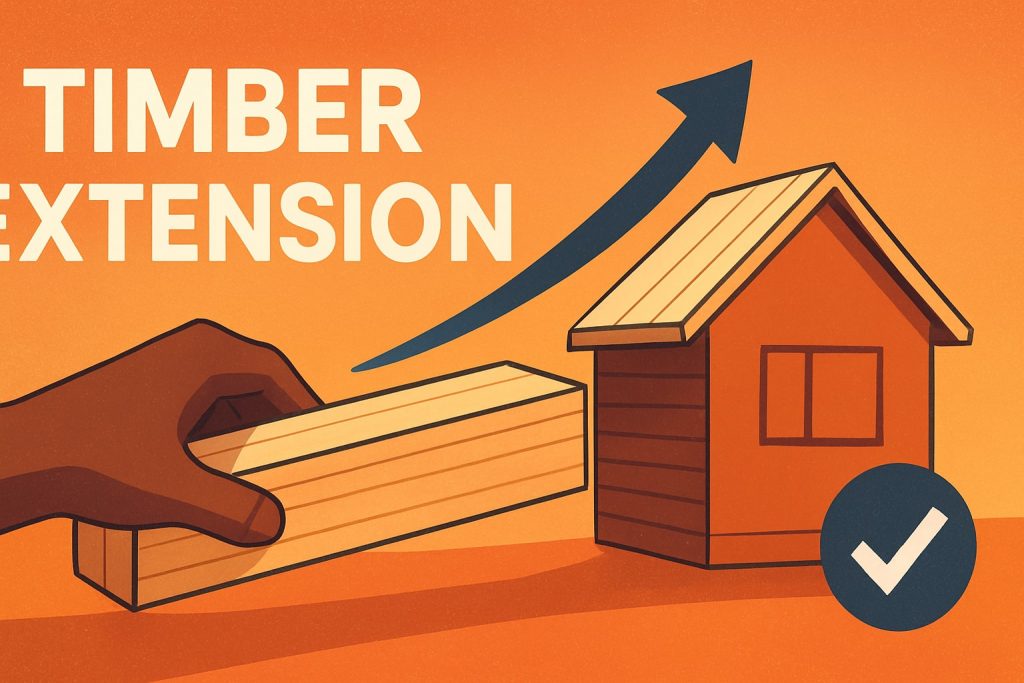Imagine transforming your home with a timber extension that adds space, boosts value, and reflects your unique style. As timber extensions surge in popularity across the UK for 2025, more homeowners are embracing this sustainable and versatile solution.
This guide will help you plan, design, and build your ideal timber extension with confidence. We will explore the benefits, costs, design tips, planning steps, regulations, and sustainability considerations you need to know.
Curious about rapid build times, energy efficiency, and design flexibility? Discover how to achieve your vision, avoid common pitfalls, and unlock the full potential of your home. Read on for expert advice and step-by-step guidance.
Why Choose a Timber Extension in 2025?
Imagine stepping into a light-filled, beautifully crafted timber extension that has transformed your home’s space and value. Across the UK, more homeowners are turning to timber extensions for their unique blend of affordability, speed, and sustainability. In 2025, the trend continues to grow, making it vital to understand exactly why a timber extension stands out as a top choice for modern home improvement.

The Appeal of Timber Extensions
A timber extension offers a cost-effective solution for homeowners looking to expand their living space without the high price tag often associated with traditional builds. Thanks to modern timber frame systems, projects can be delivered rapidly, with minimal disruption to daily life. Prefabricated panels are assembled off-site, ensuring accuracy and efficiency, then installed swiftly on location.
There is a wide range of timber extension types to suit every need, including single storey, two storey, wraparound, and bespoke designs. This flexibility allows you to tailor the extension to your lifestyle, whether you need an open-plan kitchen, an extra bedroom, or a dedicated workspace.
Timber naturally provides excellent insulation, keeping your home warm in winter and cool in summer. Its eco-friendly credentials make it an attractive choice for sustainability-minded homeowners. For example, recent projects in Berkshire and Hampshire have demonstrated how quickly a timber extension can be completed, with some reaching weathertight status in just a matter of days.
If you want a deeper understanding of the benefits and methods behind timber construction, the Timber frame homes overview offers valuable insights into why timber extensions have become so popular.
Key Benefits Over Traditional Builds
One of the most significant advantages of a timber extension is the speed of construction. Unlike traditional brick or block builds, timber frame structures can be made weathertight in days, not weeks. This means less time spent on site and reduced disruption to your household routine.
Labour costs are often lower, as much of the work is completed off-site. There is also less dependency on good weather, which is a major benefit in the unpredictable UK climate. Off-site manufacturing leads to minimal site waste, supporting both cost savings and environmental goals.
Energy efficiency is another key benefit. Timber extensions are designed for superior airtightness and insulation, resulting in lower energy bills and a more comfortable home. Homeowners often report that the rapid assembly and minimal disruption exceeded their expectations, with many appreciating how seamlessly the new space integrates with their existing property.
Compared to traditional builds, a timber extension not only saves time and money but also delivers a high-quality, energy-efficient living environment. These benefits are backed by numerous client testimonials, highlighting the positive impact on both lifestyle and property value.
Trends and Innovations for 2025
As we move into 2025, the demand for sustainable, low-carbon building materials is at an all-time high. Timber extension projects are increasingly favoured for their green credentials and alignment with modern environmental targets.
There is a notable rise in the integration of smart home technology, enabling homeowners to control lighting, heating, and security with ease. Contemporary design trends lean towards large glazed areas, open-plan layouts, and modular solutions that can be tailored to individual requirements.
Modular and prefabricated timber extension systems are gaining popularity, offering even faster build times and enhanced quality control. According to industry data, timber frame extensions now account for a significant share of home improvement projects in the UK, reflecting a broader shift towards sustainable construction.
For anyone considering a timber extension, these trends signal a future where homes are not only more beautiful and functional but also more environmentally responsible and technologically advanced.
Step-by-Step Guide: Planning Your Timber Extension
Planning your timber extension is a journey that transforms your home from vision to reality. By following a structured approach, you can avoid common mistakes and ensure your project delivers both value and beauty. This guide walks you through each step to help you achieve your ideal timber extension with confidence.
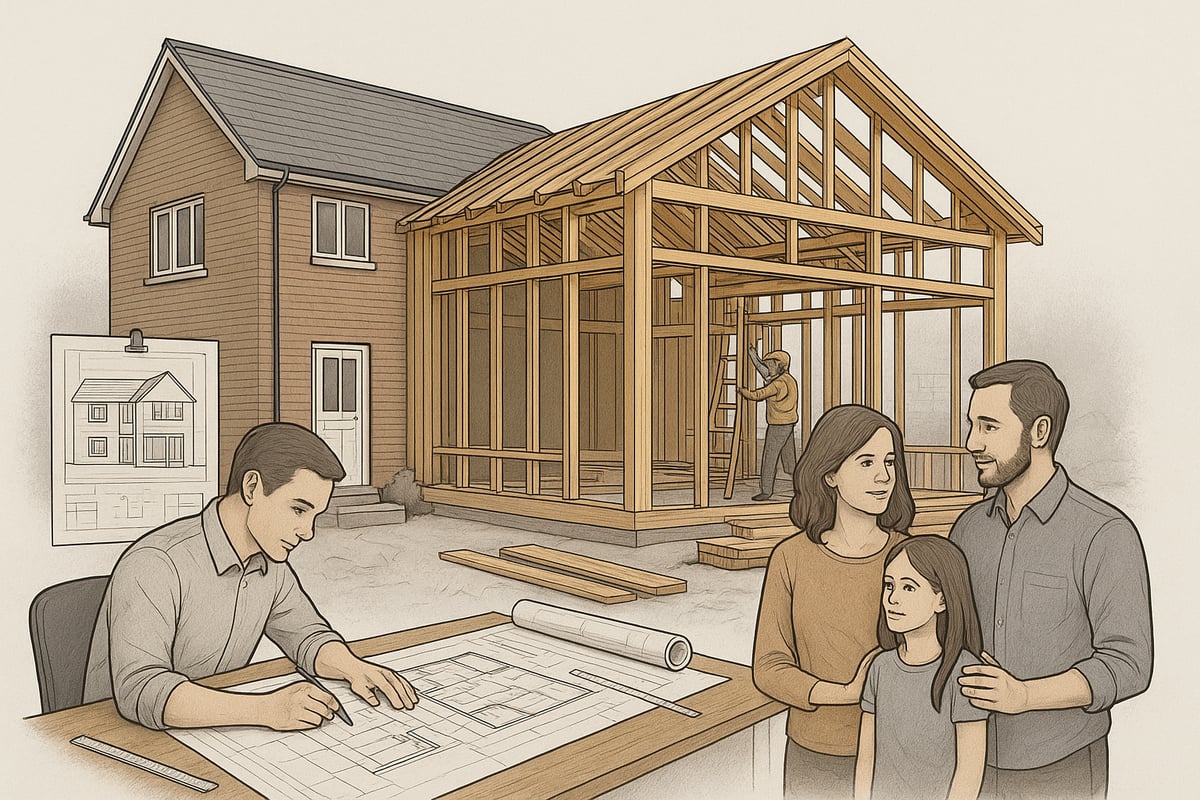
Step 1: Define Your Vision and Needs
Begin by considering why you want a timber extension and what you hope to achieve. Are you seeking more space for a growing family, a dedicated home office, or an open-plan living area? Assess your current and future requirements to ensure your plans suit your lifestyle and add long-term value.
Look at recent UK timber extension projects for inspiration. These can help you visualise what is possible and clarify your priorities. Reviewing a timber extension project gallery can spark ideas for layouts, finishes, and connection with your existing home.
Take note of how others have incorporated natural light, maximised garden views, or created flexible spaces. Pinpoint must-have features and list nice-to-haves. This early clarity will shape every decision that follows in your timber extension project.
Step 2: Budgeting and Cost Considerations
Accurate budgeting is vital for a successful timber extension. Start by understanding the typical cost range compared to traditional builds. Timber extensions often cost less due to reduced labour and faster assembly, but prices vary based on size, complexity, materials, and your location.
Key cost factors include:
- Size and footprint of the extension
- Choice of finishes and glazing options
- Site preparation and access
- Professional fees (architects, engineers, planning)
Always include a contingency fund, typically 10-15 percent of your budget, to cover unexpected expenses. Research shows a timber extension is usually more affordable than a brick build, offering excellent value for money while delivering high-quality results.
Step 3: Finding the Right Professionals
Selecting the right team is crucial for your timber extension’s success. Seek out architects and designers with proven experience in timber frame projects. Structural engineers will ensure your plans meet safety and performance standards, while specialist timber frame companies bring technical expertise and craftsmanship.
When interviewing professionals, ask:
- What experience do you have with timber extension projects?
- Can you provide references or case studies?
- How do you manage planning and building regulations?
- What is your approach to sustainability and material sourcing?
Working with knowledgeable experts will streamline your project, reduce risks, and ensure your timber extension is built to the highest standards.
Step 4: Design and Customisation
Your timber extension should reflect your home’s character and your personal tastes. Work with your design team to create a layout that complements your existing property while meeting your needs. Choices in cladding, roofing, and glazing can dramatically change the feel and appearance of your extension.
Popular customisation options include:
- Timber cladding for a natural look
- Zinc or slate roofs for contemporary style
- Large glass panels or sliding doors for light-filled interiors
Consider how your timber extension connects indoor and outdoor spaces and how finishes will age over time. Thoughtful design and bespoke touches will ensure your extension feels like a natural part of your home.
Step 5: Timeline and Project Management
A well-managed timeline is essential for a smooth timber extension build. Projects typically move from design and planning, through off-site manufacturing, to on-site assembly and finishing. One of the main advantages of timber construction is speed—off-site fabrication means structures can be erected on-site in days, reducing disruption.
To keep your project on track:
- Set clear milestones with your contractor
- Confirm delivery dates for materials and prefabricated elements
- Plan for living arrangements if work affects main living areas
Good communication and regular progress checks help avoid delays. With careful management, your timber extension can be delivered efficiently, letting you enjoy your new space with minimal stress.
Timber Extension Design Considerations
Designing a timber extension requires careful consideration of sustainability, structural methods, integration, and the use of natural light. Each of these factors will influence not only the look and feel of your new space but also its long-term performance and environmental impact.
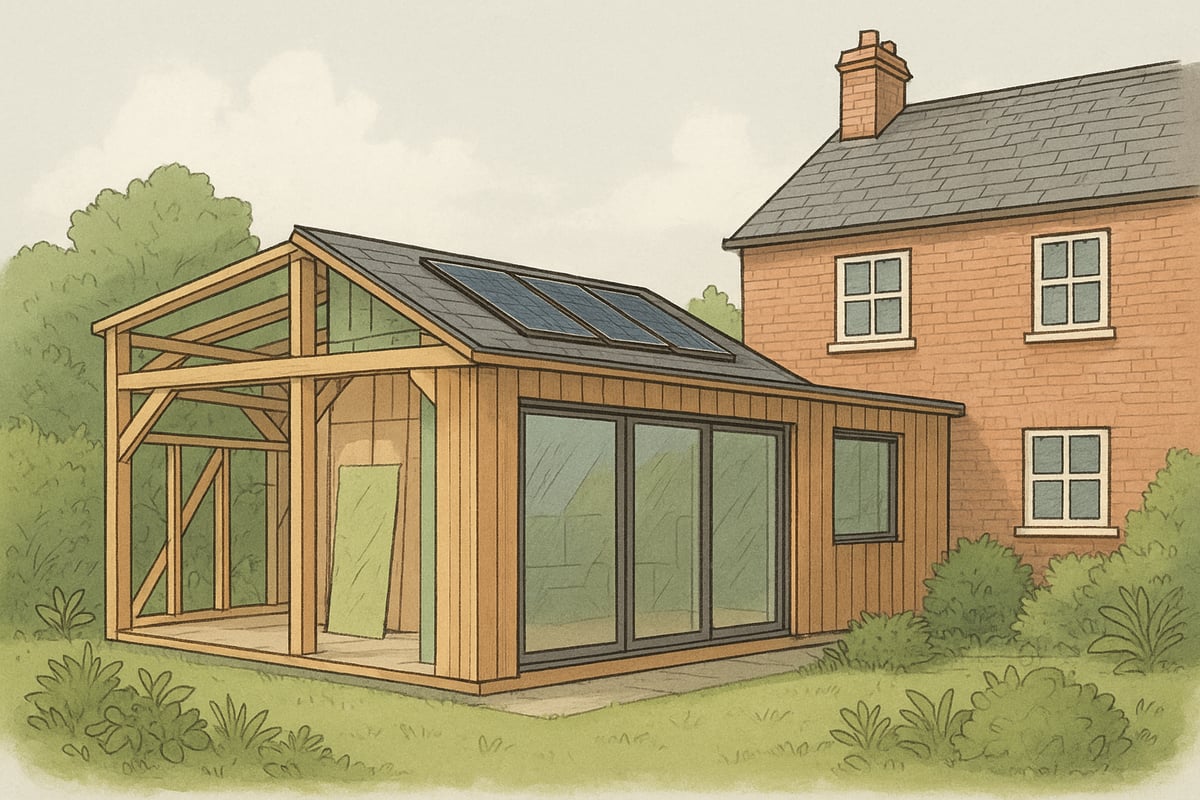
Sustainability and Energy Efficiency
A timber extension stands out as a highly sustainable choice for UK homeowners. Timber is a renewable resource with a significantly lower carbon footprint than brick or steel, making it ideal for eco-conscious projects. Its natural insulation properties help maintain a comfortable indoor temperature and reduce heating bills throughout the year.
When planning a timber extension, look for materials certified by the FSC or PEFC to ensure responsible sourcing. These certifications guarantee that the wood comes from well-managed forests, supporting biodiversity and ethical practices. The UK government’s Timber in Construction Roadmap 2025 outlines strategies to increase sustainable timber use, emphasising the importance of energy efficiency and fire safety in modern extensions.
Opting for high-performance insulation and careful detailing around doors and windows will further enhance energy efficiency. By choosing a sustainable design, you invest in the future while enjoying lower running costs and a healthier living environment.
Structural Options: Stick-Build vs. Prefabricated Panels
Selecting the right construction method for your timber extension is crucial for both budget and build efficiency. There are two main approaches: stick-build and prefabricated panels.
Stick-build involves assembling the timber frame piece by piece on site. This method is ideal when access is restricted or when the extension design is highly bespoke. It allows for minor adjustments during construction, which can be essential for complex sites.
Prefabricated panels, on the other hand, are manufactured in a factory and delivered ready to install. This approach offers greater accuracy, faster build times, and reduced site waste, making it a popular choice for many UK projects.
| Method | Best For | Advantages |
|---|---|---|
| Stick-build | Restricted access, bespoke designs | Flexibility, on-site changes |
| Prefabricated panels | Standard and modular builds | Speed, precision, less waste |
Carefully assess your site conditions and project requirements before deciding which structural solution best suits your timber extension.
Integrating with Existing Structures
Blending your timber extension seamlessly with your current home is essential for both aesthetics and structural integrity. Common challenges include matching floor levels, aligning eaves, and ensuring rooflines connect smoothly. Accurate site measurements and detailed planning at the outset are critical to avoid issues later in the build.
In some cases, early demolition of parts of the existing structure may be necessary to achieve a precise fit. This step can also reveal hidden obstacles, such as old foundations or services, which should be addressed before construction begins.
To achieve a cohesive look, consider using complementary materials and finishes. For example, timber cladding or matching brickwork can help unify the old and new elements. With careful integration, your timber extension can look as though it has always been part of your home.
Maximising Natural Light and Space
One of the major advantages of a timber extension is the ability to introduce generous amounts of natural light and create a sense of openness. Large windows, skylights, and glazed doors are commonly used to brighten interiors and connect living spaces with gardens.
Glulam or steel frames can support expansive glazing, allowing for striking glass walls or open-plan layouts. These features not only enhance the aesthetic appeal but also improve wellbeing by flooding rooms with daylight.
When planning your timber extension, work with your designer to optimise the orientation and placement of windows. This ensures each room benefits from sunlight throughout the day. Thoughtful design choices will help your extension feel bright, spacious, and perfectly tailored to your lifestyle.
Navigating Planning Permission and Building Regulations
Securing the right permissions and meeting building regulations are essential steps for any timber extension project. Understanding the process early helps avoid costly delays and ensures your new space is safe, compliant, and ready for use.
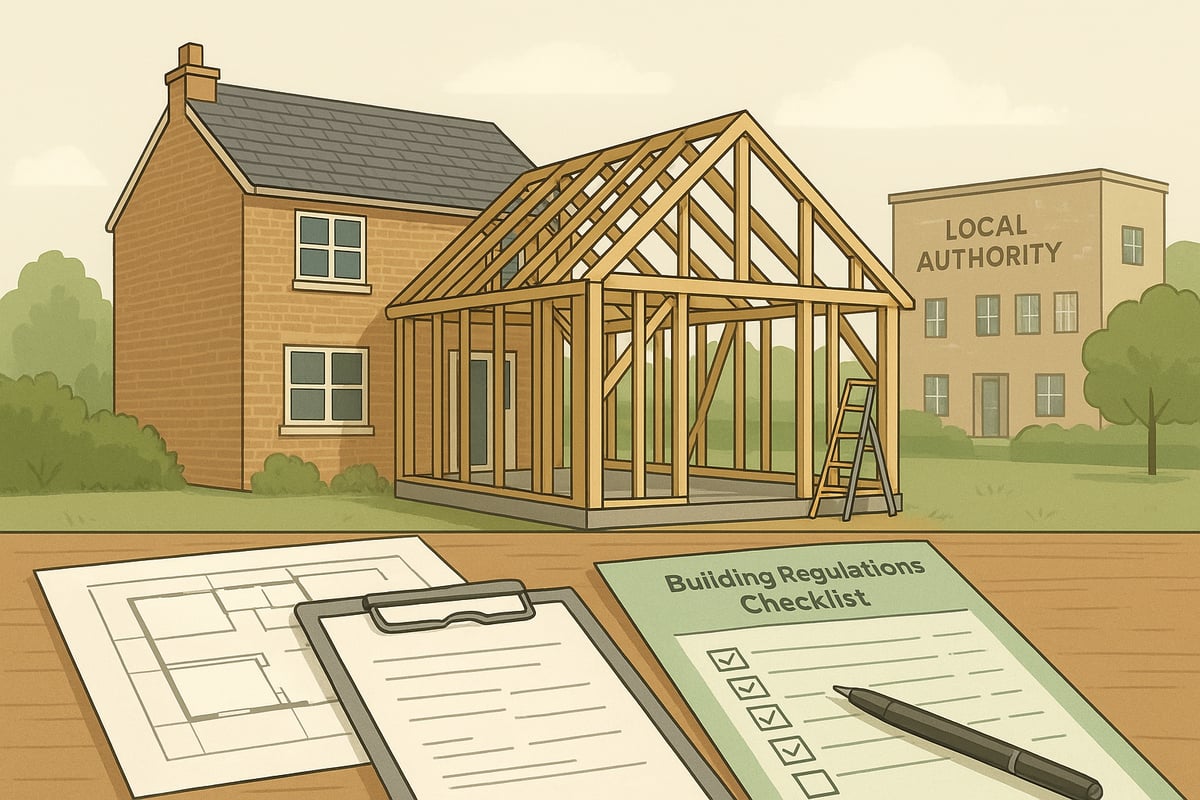
Understanding Permitted Development Rights
For many homeowners, a timber extension may fall under permitted development (PD) rights, allowing you to bypass a full planning application. PD rights specify what you can build without formal permission, but there are strict criteria. These include limitations on the extension’s size, its height, and its location in relation to your property’s boundaries.
If your planned timber extension exceeds these limits, is within a conservation area, or involves a listed building, you will need to submit a full planning application. Always double check with your local authority before starting work, as rules can vary by region and are subject to change.
Key PD criteria to consider:
- Maximum extension depth and height
- Percentage of land covered
- Proximity to boundaries and public roads
Taking time to understand these requirements ensures your timber extension project gets off to a compliant start.
Building Regulations for Timber Extensions
Regardless of planning permission, every timber extension must meet UK building regulations. These regulations ensure your extension is structurally sound, energy efficient, and safe for occupants. Core areas include structural safety, fire resistance, insulation, and ventilation.
You will need to submit detailed plans and calculations to your local building control department. Regular inspections will take place at key stages, from foundation to completion, to verify compliance. Using reputable professionals is essential to ensure every aspect meets current standards.
For further detail on construction methods and compliance, you may find Log and timber frame insights a helpful resource.
Adhering to building regulations not only ensures safety but also protects the long-term value of your timber extension.
Working with Your Local Authority
Engaging proactively with your local authority streamlines the timber extension process. Begin by preparing clear, accurate drawings and supporting documents for your application. Maintain open communication with planning officers and building control throughout the project.
Tips for a smooth approval process:
- Double-check all submitted plans for accuracy
- Respond promptly to queries or requests for more information
- Keep a record of all correspondence and approvals
When you work closely with your local authority, you reduce the risk of delays and ensure your timber extension meets all necessary requirements. This collaborative approach results in a compliant, well-executed project that enhances your home’s value and functionality.
Cost Breakdown and Value Added
Understanding the financial side of a timber extension is crucial for homeowners aiming to maximise both their living space and investment. Clarity on costs, funding options, and the value added will help you plan with confidence and avoid surprises along the way.
Upfront and Ongoing Costs
Budgeting for your timber extension starts with understanding the primary cost components. These typically include materials, labour, design, planning, and site preparation. The cost of a timber extension is generally lower than a traditional brick build, with savings arising from reduced labour hours and faster construction. According to industry experts, a significant portion of the budget goes towards high-quality timber and precision off-site manufacturing.
Here is a simplified table breaking down typical costs:
| Cost Category | Percentage of Total Budget |
|---|---|
| Materials | 35% |
| Labour | 25% |
| Design & Planning | 15% |
| Site Preparation | 15% |
| Contingency | 10% |
Ongoing savings are another key advantage of a timber extension. These structures are known for superior energy efficiency, leading to lower heating bills and reduced maintenance over time. For a detailed breakdown of costs and what to expect, consult this Cost of Timber Frame Extensions guide.
Financing Your Extension
Securing finance for your timber extension project is an important early step. Most homeowners rely on mortgages, home improvement loans, or personal savings to fund the work. When applying for finance, it is essential to ensure your lender is comfortable with timber construction and your chosen external finishes.
Some lenders may have specific requirements for timber projects, so clarify their policies before committing. In 2025, look out for green mortgages or grants that reward sustainable building practices, which could help reduce your overall expenditure. Government incentives may also be available for eco-friendly upgrades, which can make your timber extension more affordable.
Careful budgeting and exploring all available financing routes will help ensure your project runs smoothly from start to finish. Engaging with a financial adviser can also provide peace of mind as you navigate the options.
Return on Investment
A well-planned timber extension enhances both the functionality and value of your property. Adding extra square footage can significantly increase your home's market appeal, especially as buyers in 2025 are prioritising sustainability and energy efficiency. Modern buyers are willing to pay a premium for homes with eco-friendly features, making your investment in a timber extension a smart move.
Market trends show that timber extension projects are increasingly in demand, with industry insights from UK Timber Industry Predictions 2025 highlighting continued growth in this sector. Homeowners often report improved quality of life and substantial financial returns, particularly when the extension is thoughtfully designed and expertly executed.
By choosing a timber extension, you are investing in a future-proof solution that delivers both immediate comfort and long-term value. Assessing potential returns as part of your planning process will help you make informed decisions and maximise the benefits for years to come.
Sustainability and the Future of Timber Extensions
Timber extension projects are increasingly recognised for their positive environmental impact, making them a preferred choice among UK homeowners. Understanding how your timber extension contributes to sustainability can help you make informed decisions for your property and the planet.
Environmental Impact and Carbon Footprint
A timber extension acts as a natural carbon sink, locking away carbon dioxide absorbed during the tree’s growth. Compared to brick, block, or steel construction, timber extension methods offer a substantially lower carbon footprint. Industry research shows that a timber extension can be up to 50% less carbon-intensive than traditional builds.
| Construction Material | Carbon Intensity (kg CO2e/m²) | Renewable Source? |
|---|---|---|
| Timber Extension | 80–150 | Yes |
| Brick/Block | 200–300 | No |
| Steel | 300–450 | No |
Choosing a timber extension over more conventional materials contributes directly to lower emissions, supporting the UK’s drive towards greener homes. Homeowners in 2025 are not only reducing their operational energy use but also the embodied carbon of their property.
Responsible Sourcing and Certifications
Ensuring your timber extension uses responsibly sourced materials is crucial for genuine sustainability. Look for timber certified by the Forest Stewardship Council (FSC) or the Programme for the Endorsement of Forest Certification (PEFC). These certifications guarantee that the wood comes from sustainably managed forests.
To verify your supplier’s credentials, request documentation and check for recognised certification logos. Many UK companies, such as those offering bespoke timber design services, lead the way in eco-conscious sourcing and transparent supply chains. By partnering with reputable specialists, you can be confident your timber extension meets the highest environmental standards.
Future Trends in Timber Construction
The future of timber extension design is shaped by innovation and the urgent need to meet net-zero housing targets by 2050. Advances in prefabrication and modular building are making timber extension projects faster, more affordable, and even lower in waste. Integration with smart home technology is also becoming standard, boosting efficiency and comfort.
Emerging construction methods, such as the Brettstapel Construction Method, are gaining popularity for their sustainability credentials and performance benefits. As the UK market’s appetite for timber extension solutions grows, expect to see even more creative uses of renewable materials, advanced manufacturing, and climate-friendly design. Timber extension projects are truly at the forefront of the sustainable building revolution.
As you look ahead to creating your ideal space in 2025, remember that a timber extension is not just about adding square footage—it is about enhancing your lifestyle, increasing your property’s value, and embracing sustainable design. With expert guidance, careful planning, and the right team, your vision can become a reality that stands the test of time. If you are ready to take the next step and want a partner who values craftsmanship, sustainability, and compliance, we are here to help. Let us bring your dream to life—BUILD NOW
